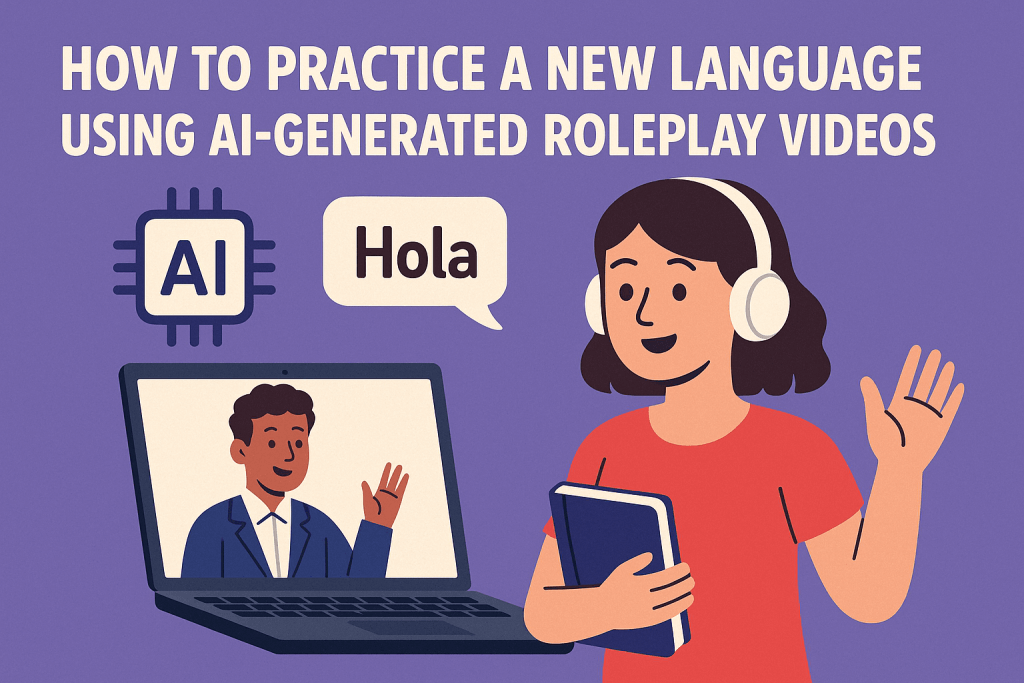If you have ever embarked on learning a foreign language (for us regular humans, not you savant polyglots) you know that if you want to learn it properly, you need more than flashcards and grammar drills. They are great for covering the basics, but if you want to have good communication skills and fluent speech, you need practice.
That’s the problem anyone who doesn’t live in a country where that language is spoken is facing. Where to speak it then; with who?
With so many technology innovations, there is a solution for this issue, and it’s called roleplay videos. If you are not familiar with it, the simple way to explain what roleplay videos are is that they are short videos that are based on a certain scenario, and they simulate real conversations.
This is the perfect way to feel more sure of yourself and to get speaking experience without the need for a second person (speaker/listener).

Why Roleplay Videos Matter
You retain language better when you actively experience the language, not just passively learning it. Roleplay videos put you in everyday situations in a way that feels more realistic. Situations like ordering food, asking for help, or even a job interview, anything can be done, and they force you to respond naturally.
They’re also practical. You get repetition without monotony, context without confusion, and speech practice without judgment. And video provides visual and audio prompts that reinforce learning.
Another benefit is that you can now create custom content with AI that generates videos. These tools enable you to write a script, choose a voice and a language, and generate a scene automatically based on your needs. Want a mock airport security conversation in French? Or a grocery store conversation in Japanese?
You can produce it on your own schedule (in minutes), and you don’t need actors or production knowledge.
3 Simple Roleplay Scenarios to Try
Start with everyday situations. Here are three scenarios that most students can relate to:
- Ordering in a cafe: First thing everyone would like to learn is to greet someone, and to be able to order by themselves, ask for a menu, and pay.
- Asking for directions: Tourists and travel lovers need this one. Practice how to ask where something is, how to respond to the answer, and how to ask for clarification if needed.
- Small talk with a coworker: Practice how to greet a coworker, how to ask them what his plans are for the weekend, etc.
How to Create Your Own Practice Videos
You don’t need a professional studio. Just a simple setup and the right equipment.
Here’s a quick 5-step breakdown:
| Step | What To Do? |
|---|---|
| Choose a scenario | Pick a daily-life situation you want to simulate. |
| Write a script | Create sample questions and answers |
| Use AI to generate | Upload your script to a video tool and select the voice + language |
| Add subtitles | Include captions in your native and target languages to help you follow along. |
| Practice response | Pause the video and speak your part |
4 Active Ways to Get the Most Out of Roleplay Videos
Passive watching is not going to be enough. Use these techniques to turn every clip into a speaking practice:
- Shadowing – Repeat the speaker’s words immediately to mimic rhythm and intonation.
- Pause and respond – Stop after each line and repeat your reply.
- Record yourself – Record your side of the dialogue and compare pronunciation.
- Role reversal – Switch off the video and read through the first half of the dialogue, let the AI be the one who responds.
By speaking actively, you are compelled to remember, speak, and correct. All of these segments are going to help you speak more smoothly, faster.
Weekly Study Plan Example
If you are struggling with how to incorporate role-play video practice in a weekly plan, here’s what you can do:
- Monday: Learn new vocabulary regarding the topic of the week.
- Tuesday: Watch your first roleplay video and watch it 2-3 times.
- Wednesday: Practice pause-and-respond and record yourself.
- Thursday: Create or make a second video on the same subject.
- Friday: Roleplay both sides from memory.
- Weekend (unless you practice some kind of vow of silence, then do the work on Sunday as well): Practice mistakes, check for grammar holes, and trim scripts.
Even 15-20 mins per day can really help you feel more at ease speaking the language. Your tongue is a muscle. You need to get used to pronouncing different words. Much like teaching your brain and muscles to ride a bike, by practicing you get better and better at speaking.
5 Tips for Maximum Impact
- Start short – Use clips less than 1 minute until you feel confident.
- Repeat often – Repetition makes it more efficient to transfer words from passive to active recall.
- Match your goals – Choose situations that are easy to relate to and participate in.
- Make it visual – Choose tools that enable you to produce videos with facial expressions or hand movements.
- Track progress – Save recordings and scripts and monitor all the improvements (regardless of how small).
Conclusion
AI-generated roleplay videos are such a great tool for language learners. They provide students with a natural, realistic way to practice speaking on their own terms. They’re easy to repeat, adjust, and use on your own time. They’re among the best tools for individual learners or those who don’t have regular speaking partners.
For business travel, business talk, or even just conversational practice, this process builds fluency by mimicking what real interaction is like.
And remember – practice makes perfect!

